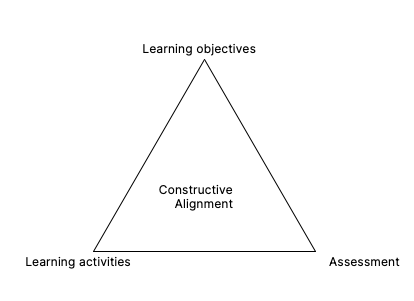ASSESSMENT (evaluation)
—‘Curriculum, pedagogy, and assessment - in that order’
Dylan Wiliam, 2023.
‘Evaluations are about making the learning visible. Or more precicely: getting evidence about behavior change in students.’ Tyler 1947, 104-125.
Are you curious for more? Would you like to get in touch? Feel free to contact our lead directly for any questions or inquiries you may have. Tikvah Breimer (MSc MAEd MSc) tikvah@studioblended.com +31 6 42 47 29 69
EDITORIAL: SETTING THE SCENE
© 2026 STUDIOBLENDED https://www.studioblended.com/Assesment-evaluationThis page is underway. Would you like to already exchange about it? Feel free to contact us directly:
Tikvah Breimer (MSc MAEd MSc)
tikvah@studioblended.com +31 6 42 47 29 69
Where does this design angle come in?
Assessment is an integral part of constructive alingment, and therefore of a fit for purpose framework, and comes in in the early (re)design stages of a course, training or (master)degree.
A good way to scope your assessment is in a Design Studio.

Our technical approach to curriculum design is based on ‘constructive alignment’. You achieve it with backward design, which has proved to be a robust technique for design. We go over and beyond mere learning activities, by partnering with you and crafting big ideas, understanding and knowledge statements in your knowledge domain, coupled with skills and capabilities. We strategize content for well into the coming decade. Source image: Biggs, J., & Tang, C. (2011). Teaching for Quality Learning at University. Maidenhead, UK: Open University Press.
AUDIO PODCAST

🎙 Keynote: Big ideas and modular curriculum design.
Prefer to read? Transcript
Listen on: Acast Spotify Apple
Release summer ‘24
KEY PROJECTS
MASSIVE OPEN ONLINE COURSE (MOOC) funded by the ERC
—
2025 - 2026 (1 year)
—
StudioBlended is currently partnering with an institute for capacity building within a European University, to co-create an impactful MOOC for this client (2025-mrch 2026).
Our curriculum design is centered on assessment, and includes both pragmatism for a MOOC, and idealism, in close collaboration with the client.
European funded program.
More information follows soon.


OUR FINITE SET OF DESIGN ANGLES
Technical resilienceBig ideas
Paradigm shifts/decade strong
Simplicity and decluttering
Human resilience
Modular
Innovative and deep pedagogy
Assesment / evaluation
Time dimension
Evidence-based design
Financial health and resilience by (re)design
Multi- Inter- and transdisciplinary
Flexibilisation and personalisation
Blended
REFERENCES
Freire, Paulo 1974 (2013) Education for critical consciousness. London New York: Bloomsbury Academic.Freire, Paulo 1970 (2000) Pedagogy of the Oppressed. New York: The Continuum International Publishing Group Inc.
Bjork, E. L., & Bjork, R. A. (2011). Making things hard on yourself, but in a good way: Creating desirable difficulties to enhance learning. In M. A. Gernsbacher, R. W. Pew, L. M. Hough, & J. R. Pomerantz (Eds.), Psychology and the real world: Essays illustrating fundamental contributions to society (pp. 56–64). Worth Publishers.
Cardozo, M.L., Wessels, K. and Van den Berg, B. (2025) The Art of Regenerative Educatorship. London: Routledge. Available: https://www.taylorfrancis.com/books/oa-edit/10.4324/9781003705321/art-regenerative-educatorship-mieke-lopes-cardozo-koen-wessels-bas-van-den-berg(Accessed: October 27, 2025)
Landymore, F. (2025). ‘Chat GPT has already polluted the internet so badly that it’s hobbling future AI development.’ Futurism, June 16 Availalbe: https://futurism.com/chatgpt-polluted-ruined-ai-development (Accessed: October 27, 2025)
Biesta, G. (2025) The future of education in the impulse society: Why schools and teachers matter. Prospects. Available: https://doi.org/10.1007/s11125-025-09723-1 (Accessed: 27 October, 2025).
Kirschner, P.A., Hendrick, C. and Heal J. (2025). Instructional illusions. London: Hachette Learning.
Mulder, R., Baik, C. and Ryan T. (2025) ‘Rethinking assessment in response to AI’. Melbourne: Melbourne Centre for the Study of Higher Education, The University of Melbourne. Available: https://melbourne-cshe.unimelb.edu.au/__data/assets/pdf_file/0004/4712062/Assessment-Guide_Web_Final.pdf
Kosmyna N., Hauptmann, E., Tong Yuan, Y., Situ, J., Liao, X., Beresnitzky, A.V., Braunstein, I and Maes, P. (2025) ‘Your Brain on ChatGPT: Accumulation of Cognitive Debt when Using an AI Assistant for Essay Writing Task’. New York: Cornell University. Available: https://arxiv.org/abs/2506.08872 (Accessed: October 27, 2025).
Risbo (2025) MicroLab (Gen)AI and assessment. Course for Erasmus University Teaching staff and associates.
Stabel, K. 2025. ‘Education in the Age of AI: A plea for Craftmanship. Blogpost by deputy director of Risbo.’ Rotterdam: Erasmus University Rotterdam. Available: https://www.linkedin.com/pulse/education-age-ai-plea-craftmanship-kris-stabel-qq7le/?trackingId=FhlKEmonRy6ulWgWK0nBWQ%3D%3D
Taveras-Dalmau, V., Becken, S. and Westoby, R. (2025) ‘From paradigm blindness to paradigm shift? An integrative review and critical analysis of the regenerative paradigm.’ Ambio (2025). https://doi.org/10.1007/s13280-025-02232-7 Available: https://link.springer.com/article/10.1007/s13280-025-02232-7#citeas(Accessed: October 27, 2025).
Resilient education that stands the test of time - by design.
Prefer to have direct contact?
Feel free to contact us:
Tikvah Breimer (MSc MAEd MSc)
Independent senior advisor, teacher trainer, director.
tikvah@studioblended.com
+31 6 42 47 29 69
STUDIOBLENDED Non Profit Foundation
Registration Chamber of Commerce
KvK-number 86242598 (Dutch)
VAT identification number
NL 86 39 07 29 5 B01
Bankaccount
NL40 INGB 0709 6156 04
SWIFT/BIC: INGBNL2A
StudioBlended Foundation
Feel free to contact us:
Tikvah Breimer (MSc MAEd MSc)
Independent senior advisor, teacher trainer, director.
tikvah@studioblended.com
+31 6 42 47 29 69
STUDIOBLENDED Non Profit Foundation
Registration Chamber of Commerce
KvK-number 86242598 (Dutch)
VAT identification number
NL 86 39 07 29 5 B01
Bankaccount
NL40 INGB 0709 6156 04
SWIFT/BIC: INGBNL2A
StudioBlended Foundation
